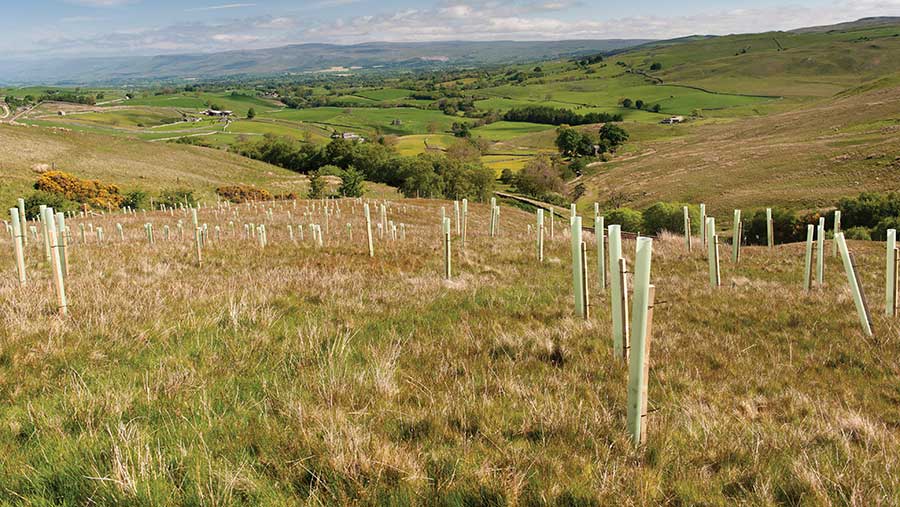Expert advice for making trees work on your farm
 © Wayne Hutchinson/Alamy Stock Photo
© Wayne Hutchinson/Alamy Stock Photo Large-scale tree planting has come under fire for taking up productive farmland and altering the character of local environments.
But the right tree, planted in the right place, can generate revenue, capture carbon and benefit biodiversity, according to an expert panel for a recent Transition Project webinar.
See also:
Trees on the farm webinar expert panel
The following experts covered issues on the benefits of woodland, where to site trees, funding and the financial potential from selling timber and carbon credits.
- Richard Pow partnerships manager Forestry Commission
- Peter Wilderspin rural surveyor overseeing Cambridge University’s rural estate
- Eddie Rixon Oxfordshire beef and sheep farmer and development adviser for Forestry Commission
- Tim Oliver managing director Wanderlands environmental consultancy
Watch the webinar here and read the rest of the report below.
Where to site trees
Every farm has marginal land where yields and profits are harder to eke out, such as frost pockets or boggy hollows.
These could be suitable for tree planting without sacrificing large areas of productive land suggested farmer and Forestry Commission adviser Eddie Rixon.
Before planting it is also wise to consider any additional potential benefits that might influence where trees should be sited.
Livestock farms could position trees to provide shelter or shade to help extend the grazing period and cut housing costs.
Alternatively, woodland can provide a valuable public amenity or educational base to attract funding.
Where the landowner is planting trees as wildlife habitats, then positioning is vital to provide the most benefit for wildlife.
Assessing maps of the farm will allow strategic planting to join up other wildlife refuges such as existing woodland, scrub and hedgerows.
This joined up approach provides a better quality habitat for a wider range of wildlife, rural surveyor Peter Wilderspin added.
Funding
Grants are available for tree planting under the England Woodland Creation Offer (Ewco) with similar schemes available in the devolved regions, explained the Forestry Commission’s Richard Pow.
Payments, based on a national average figure, cover 100% of the capital items and activities involved in planting woodland.
Beyond that, the scheme continues to make maintenance payments of £350/ha each year for the first 10 years to help establish the trees.
Other funding under Ewco includes payments towards installing infrastructure, such as maintenance tracks.
Applications for multiple, additional funding on the same woodland will also be considered if it is sited where the public might benefit from access.
It is also advisable to research local funding streams, Richard added. Although Ewco does not support agroforestry ventures such as tree strips across arable fields, some local authorities will offer grants for this activity.
Carbon
About half the mass of a dried cubic metre of timber is composed of carbon, estimated Richard.
There is a growing market for this carbon store as the government and other industry bodies push towards net zero targets.
To meet targets businesses are required to offset their residual carbon output – the amount remaining after all other methods of reducing carbon impacts have been exhausted, Wanderlands’ Tim Oliver explained.
A net-zero carbon balance can then be achieved by the business purchasing offsets from stored carbon like woodland for the residual amount, he said.
To access the market, the first step – before planting – is to register with the Woodland Carbon Code.
Failure to do so will mean the grower will not be able to access the regulated carbon markets. Acceptance on to the WCC register is based on the condition of additionality.
The woodland proposal will be assessed according to the extra amount of carbon it will capture compared with the existing farming practice.
Carbon offset trading can then begin 10 years after planting. This means there is an opportunity to create a revenue stream from woodland well before the typical 20 years required for a timber crop to develop.
The carbon offset market is growing and while current values are £40-50/t, forecasts suggest the price will increase to about £100/t in the next decade, said Tim.
A further option is to sell before the 10-year establishment period is over by offering Pending Issuance Units (PIUs).
These can be sold even while receiving Ewco funding but their value is roughly half that of a unit marketed after the 10-year period is over.
Timber
Finally, Richard urged potential growers not to overlook the timber market.
Britain is the second biggest importer of woodland and the government recognises the value of home-grown stocks.
That is reflected in the HMRC applying a 0% rating for both income and corporation tax and there is no cap on revenue levels.
